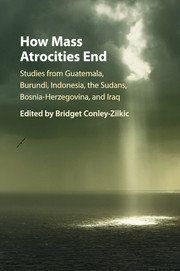 How Mass Atrocities End
How Mass Atrocities End Introduction
Published online by Cambridge University Press: 05 February 2016
- Type
- Chapter
- Information
- How Mass Atrocities EndStudies from Guatemala, Burundi, Indonesia, the Sudans, Bosnia-Herzegovina, and Iraq, pp. 1 - 28Publisher: Cambridge University PressPrint publication year: 2016
References
Works Cited
- 1
- Cited by
